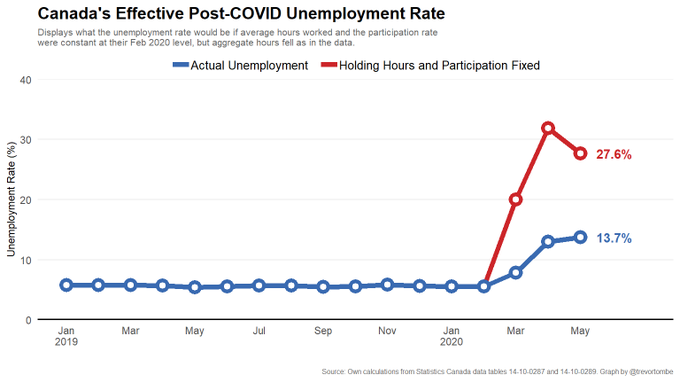
As governments gradually lift restrictions linked to COVID-19, scores of unemployed Canadians have started looking for jobs.
What they face is very different from the pre-pandemic labor market, says Carolyn Levy of Randstad Canada.
At the beginning of the year, the country’s unemployment rate was hovering around 5.5 per cent, close to a record low. That was after the jobless rate had kept firmly under six per cent for all of 2019.
“It was a job-seekers’ market for a couple of years,” Levy says.
Now things have “really changed,” she adds.
Unemployment stood at an all-time high of 13.7 per cent in May, according to the latest available data from Statistics Canada. And that figure doesn’t come close to capturing the full impact of the pandemic on the labor market, economists warn.
University of Calgary professor Trevor Tombe, for example, put the effective jobless rate in May at 27.6 per cent, an estimate that accounts for those who were formally employed but working zero hours and unemployed people who weren’t actively looking for a job.
But the May labor market report also showed a gain of nearly 290,000 jobs, as businesses gradually reopened across Canada.
Indeed Canada said the trend in total job postings on its site was 41 per cent below last year’s pace as of June 12 compared to 43 per cent below year-ago levels the previous week and 48 per cent the previous month.
While hiring remains “subdued,” the rebound has started, with the pace of the recovery in total postings improving especially since mid-May, according to Indeed economist Brendon Bernard.
But some sectors are bouncing back faster than others.
Confidence among workers and jobseekers in manufacturing and construction, for example, has “really taken off,” as factories and building sites begin to reopen across the country, says LinkedIn news editor Riva Gold.
Meanwhile, the demand for front-line workers in both the health-care and retail sectors is likely to remain elevated for as long as parts of the economy remain in lockdown, Gold says.
Parts of the retail industry have been devastated by the effects of the health emergency. But large retailers like Save-On-Foods, Walmart Canada, and Dollarama announced plans to ramp up hiring in the early stages of the pandemic in order to meet a surge in demand for consumers stocking up on food, toilet paper, and other essentials.
Dollarama says it has hired “thousands of employees” since the beginning of the pandemic and is still adding jobs. “We continue to hire across Canada in the normal course of business and as our store network grows,” the company said in a statement to Global News.
Metro is also still taking on new recruits, with an emphasis on roles that are necessary to serve customers in stores and pharmacies, according to the company’s website.
Cleaners are another category for which the pandemic has created an increased need, says Randstad’s Levy.
In addition to stores and pharmacies, gyms are among the businesses growing their cleaning staff, Levy says. And those tend to be permanent positions, reflecting employers’ uncertainty about how long the current situation will last, she adds.
Also in high demand are those working in customer support, according to Randstad.
“Trust is a big issue,” when consumers are buying remotely, Levy says.
Online business has fuelled the need for more people answering phones, emails, and social media queries to make sure that customers feel “heard and supported,” she adds.
The e-commerce surge tied to the pandemic has pushed online sales to a record-high of nearly 10 per cent of the total retail market, according to Statistics Canada.
This is also creating new demand for warehouse support and drivers, according to Levy.
Job postings for loading and stocking roles such as forklift operator and positions in shipping and receiving have seen an uptick in recent weeks, Bernard says.
And more business moving online as storefronts closed likely also created a need for tech upgrades and the software developers able to implement them, Bernard says.
In general, the IT services sector has withstood the slump well, data shows.
Worker sentiment in the industry has remained at “fairly steady, high levels” throughout the pandemic both in terms of job security and career outlook, according to LinkedIn’s Gold.
“There is still a talent shortage in that space,” Levy says.
Tech companies have continued to hire throughout the lockdown.
Video game developer Ubisoft, for example, has more than 100 openings in Montreal.
And workplace messaging platform Slack told Global News it’s currently looking to fill 11 positions for its Toronto and Vancouver offices, although it recently announced most employees will have the option to work remotely on a permanent basis if they wish.
While the company said the pandemic hasn’t changed its short-term hiring plans in Canada, there’s little doubt the future looks bright from where Slack is sitting.
The company saw 50 per cent revenue growth year-over-year for the quarter ended April 30 as the shift to remote work increased demand for online platforms that enable employees to stay connected and work in teams.
Slack co-founder and CEO Stewart Butterfield have called the results “phenomenal.”
“We believe the long-term impact the three months and counting of working from home will have on the way we work is of generational magnitude,” he added.
© 2020 Global News, a division of Corus Entertainment Inc.





